Introduction
Islamic architectural design has been influenced by several factors. Some of these factors include the climate (environmental factors), the culture and religion of the people and the building materials that are available (Ghobadian, 1998). Some of the areas in the Islamic countries are plateau plains with a dry climate. Iran, for example, has such a climate. Areas such as Dasht-e-Kvir receive very little rain annually. In addition, the temperatures are always at an all-time high during the hot season. This is accompanied by extreme radiation of sunlight.
The geographical situation of the area determines the air temperature of that area. Other factors that affect it include the direction of the wind and the sea level. The climatic conditions in these areas are usually extreme. They are characterized by hard and cold winters. On the contrary, the climate of the region may be warm and dry during summer. The humidity may be very low and the rainfall low as well. The difference in temperatures between night and day is very high. The dusty winds in the region are also a consideration when it comes to architectural design.
Hot and Dry
Architectural considerations of the cities
The Islamic cities in the hot and dry regions usually resemble cactus bushes. This is because the living spaces of those areas are carefully protected against the strong winds (Tavassoli, 1983). These areas include the urban regions, paths and houses. At the same time, however, the architectural layout ensures that the desirable winds and a reasonable amount of solar radiation are used as desired. The urban areas are designed in such a way that the buildings are compressed and combined. The buildings’ walls are merged such that it is not possible to define the border. This merging and combining of houses cause each of the building’s outer surfaces to be led. This phenomenon helps the buildings conserve energy for longer periods.
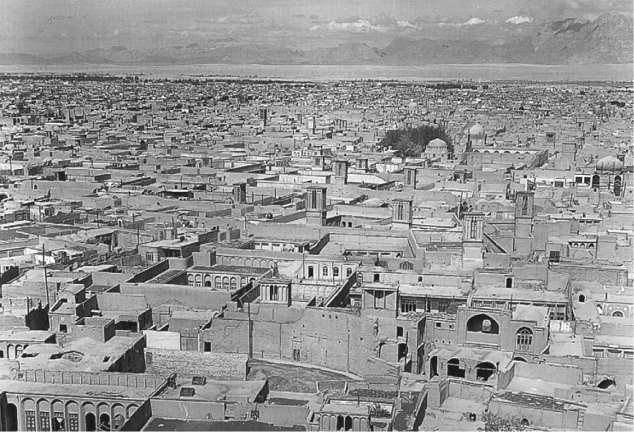
The narrow lanes are at times fitted with high walls and arches that are roofed. These components provide a shading effect on the houses around the walls. They also help control the wind speeds blowing across the land. The architectural design of the city with respect to the wind resembles the artery system. They are open to the areas that provide desirable winds and are closed to those areas that blow undesirable winds. This plan also prevents sand storms from blowing into the cities.
The architecture of the buildings
The courtyards of the buildings usually have an environmental function (Memariyan, 1994). They are usually designed in such a way that they are long and narrow. This helps to cast a large shadow on the area to provide enough shade during the summer season.
There is usually a belowground courtyard with different vegetation and a pond. This usually provides a place for inhabitants. This area also helps increase the relative humidity of the area. Using this mechanism, provides a type of cooling system for the houses. The openings and entrances act as connecting spaces that help circulate the cool air. This acts as an air conditioner.
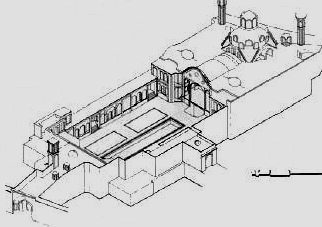
The types of roofs used in the area also serve the purpose of regulating the climatic conditions (Tavassoli, 1974). In the hot and dry areas of the Islamic regions, the roofs of several structures are designed with a dome shape. This shape has a thermo-physical aspect. The dome shape provides an unbalanced surface area for the sun’s rays. The incident angle of the sun’s rays is reflected away from the surface. However, other buildings possess flat roofs. When this is done, there is the use of bricks. They receive most of the sun’s radiation. This helps to change the intensity of solar radiation and incident angle.
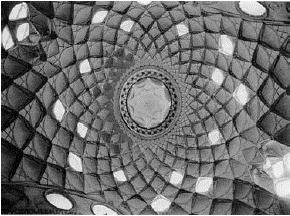
The walls of these areas are also designed to serve the purpose of mitigating the climatic conditions. They are usually very thick and this helps to transfer the heat across the walls through radiation. This helps regulate the temperatures appropriately during the day and night. With the regulated temperature, the comfort of the residents is guaranteed. The windows in such areas are also designed in a specific manner. They are usually placed at the top, close to the ceilings. These windows help in internal ventilation.
There is also the use of wind catchers. These elements of the buildings help in cooling and ventilation.
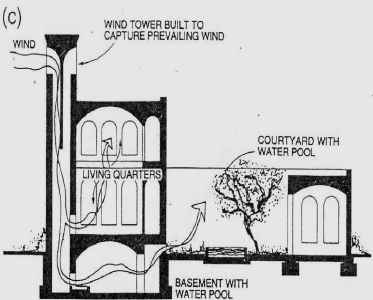
The suitable materials to be used in the construction of the buildings in such regions are mud, mortar and wood, among others. These materials are best suitable due to their thermo-physical characteristics. They have the capacity to absorb the sun’s radiation due to the characteristics of their surfaces. Since these materials are also porous, the air between them gives them characteristics similar to insulators. Due to the hot and dry conditions, it was also necessary to build deeper yards. This increased the ease of access to the underground water. These areas were then filled with vegetation in order to act as a fresh air generator. The floors of the yard contain bricks. These areas are at times cleaned with water to keep them cool.
Hot and Wet
On the other hand, other regions have a hot and wet climate. Therefore, certain architectural elements must be used in the construction of their buildings. From this type of climate, three architectural elements have been designed (Hyde, 2000). The first aspect of their architecture that responds to this climatic condition is the fact that most of their cities and buildings are built close to each other. This form of construction leads to the formation of narrow alleys. These alleys were mostly shaded. They were also designed in such a way as to run from the northern end to the southern end. They also ended at the creeks. This provided space for the prevailing north winds to pass. When wind passes through these small spaces, it increases in speed. This was necessary to create some breeze that made them comfortable for the inhabitants passing through them.
Buildings in hot and wet climates
The buildings in hot and wet climates must be built differently from those built in the hot and dry climate. In the dry climate, the use of heavy building materials was necessary to moderate the temperature. This was observed in the buildings with walls as thick as 1 meter. In the hot and wet climates, however, this should not be the case. This is because such materials may be damaged when mold grows on them due to the condensation of the humid air. Houses in such climates are also more prone to decay and rust.
Areas with this type of climate are highly humid and this may be uncomfortable if the temperature of the air is higher than that on the skin. Therefore, buildings in such areas require proper ventilation (Poor and Reza, 1999). The architecture of the Islamic cities is designed in order to allow the breeze to flow through. The buildings are placed in such a way that the breezes are funnelled. As the spaces between the buildings narrow, the breeze speeds up.
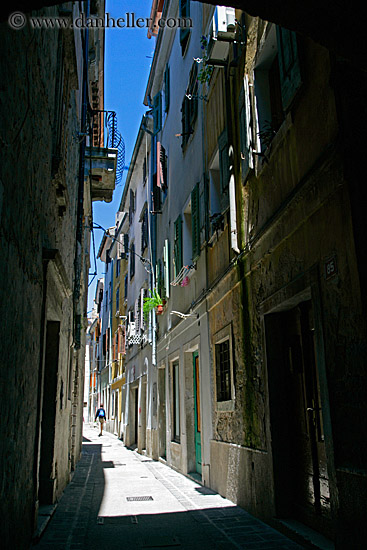
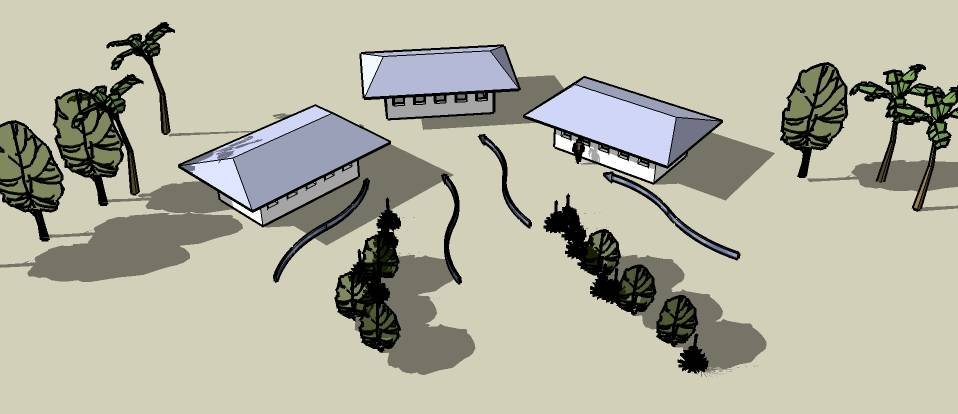
This forms a cool breeze that cools the pedestrians. The buildings are then fitted with several windows in order to allow the breeze in. The high walls also help keep sunlight off the walls of the buildings. Their buildings also have high ceilings. This is so to let the hot air rise. This would leave the people below feeling cooler and more comfortable. The breeze also helps to cool off their bodies since the skin cools as the moisture evaporates from it.
Conclusion
It can be concluded that Islamic architecture has been greatly influenced due to its responsiveness to the environment and climate of the area. The major climatic conditions of the Islamic areas include hot-dry climates and hot-wet climates. The architectural designs are meant to moderate the hot temperatures of the region and this may be achieved through the use of high walls and narrow alleys. This is meant to make good use of the air currents in the moderation of air temperatures in the buildings and the surrounding areas. The hot and wet climate has also greatly influenced the architectural design of Islamic buildings. This is done in such a way as to make the hot and humid air more comfortable.
References
Ghobadian, V 1998, Climatic Analysis of the Iranian Traditional Buildings, Tehran University Publications, Tehran.
Hyde, R 2000, Climatic Responsive Design, E & FN SPON, New York.
Memariyan, G 1994, Introduction to House typology in Iran: Courtyard houses, Iran University of Science and technology, Iran.
Poor, J &Reza, M 1999, Design criteria for development of settlements in arid coastal region of Iran (case of study of Bandar Lenghe), Tehran University Publications, Tehran.
Tavassoli, M 1983, City planning in the hot and dry climate of Iran, New York: G. Golanyed.
Tavassoli, M 1974, Architecture of hot arid climate, Tehran University, Tehran.